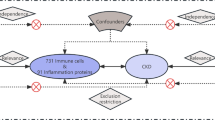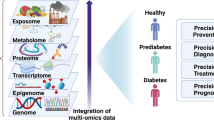Abstract
A severe, chronic and irreversible kidney disease affecting discrete rural populations in the Balkan Peninsula countries, Balkan endemic nephropathy (BEN) has been a scientific puzzle for more than half a century. Many environmental and other factors have been suggested as the primary cause and recent significant findings have linked BEN to aristolochic acids, phytotoxins derived from the plant Aristolochia clematitis, found in high density in the endemic areas. However, given that the incidence of BEN is less than 10% in affected villages, and it tends to have a family aggregation, as yet unidentified genetic factors may also play a role. To further explore this possibility, a pilot study was initiated to investigate the DNA methylation of CYP1A1, CYP1A2, NAT1, NQO1 and GSTT1 in blood samples from a group of Romanian BEN patients, compared to healthy controls and non-BEN chronic kidney disease (CKD) subjects. Our study revealed a more pronounced hypomethylation pattern in BEN and non-BEN CKD groups, compared to the healthy control group at specific CpGs across all five genes interrogated. Average methylation across the five regions investigated indicated significant differences only at GSTT1, in both BEN patients (p = 0.028) and non-BEN disease subjects (p = 0.015), relative to healthy individuals. Since GSTT1 active genotype appears to be a common feature of Serbian and Romanian BEN patients, GSTT1 epigenetic variation and increased gene activity could act as a predisposing (co)factor in BEN populations from the affected countries. BEN and non-BEN CKD groups show similar methylation patterns with exception of GSTT1 CpG8 (p = 0.046).







Similar content being viewed by others
References
Pavlović NM (2013) Balkan endemic nephropathy—current status and future perspectives. Clin Kidney J 6(3):257–265. https://doi.org/10.1093/ckj/sft049
Andonova IE, Sarueva RB, Horvath AD, Simenov VA, Dimitrov PS, Petropoulos EA et al (2004) Balkan endemic nephropathy and genetic variants of glutathione S transferases. J Nephrol 17(3):390–398
Staneva R, Rukova B, Hadjidekova S, Nesheva D, Antonova O, Dimitrov P et al (2013) Whole genome methylation array analysis reveals new aspects in Balkan endemic nephropathy etiology. BMC Nephrol 14:225. https://doi.org/10.1186/1471-2369-14-225
Gruia AT, Oprean C, Ivan A, Cean A, Cristea M, Draghia L et al (2018) Balkan endemic nephropathy and aristolochic acid I: an investigation into the role of soil and soil organic matter contamination, as a potential natural exposure pathway. Environ Geochem Health 40:1437–1448. https://doi.org/10.1007/s10653-017-0065-9
Karimi R (2015) Biomedical & biopharmaceutical sciences with patient care correlations. Jhons Bartlett Learning, Burlington
Knights KP (2013) Renal drug metabolism in humans: the potential for drug–endobiotic interactions involving cytochrome P450 (CYP) and UDPglucuronosyltransferase (UGT). Brit J Clin Pharmacol 76(4):587–602. https://doi.org/10.1111/bcp.12086
Chen B, Bai Y, Sun M, Ni X, Yang Y et al (2012) Glutathione S-transferases T1 null genotype is associated with susceptibility to aristolochic acid nephropathy. Int Urol Nephrol 44:301–307. https://doi.org/10.1007/s11255-011-0082-z
Grant DM (1991) Detoxification pathways in the liver. J Inherit Metab Dis 14(4):421–430
Gu X, Manautou J (2012) Molecular mechanisms underlying chemical liver injury. Expert Rev Mol Med 14:E4. https://doi.org/10.1017/S1462399411002110
Toncheva DI, Von Ahsen N, Atanasova SY, Dimitrov TG, Armstrong VW, Oellerich M (2004) Identification of NQO1 and GSTs genotype frequencies in Bulgarian patients with Balkan endemic nephropathy. J Nephrol 7(3):384–389
Ghotbi R, Gomez A, Milani L, Tybring G, Syvänen AC, Bertilsson L et al (2009) Allele-specific expression and gene methylation in the control of CYP1A2 mRNA level in human livers. Pharmacogenom J 9:208–217
Coolen MW, Statham AL, Gardiner-Garden M, Clark SJ (2007) Genomic profiling of CpG methylation and allelic specificity using quantitative high-throughput mass spectrometry: critical evaluation and improvements. Nucleic Acids Res 35:e119. https://doi.org/10.1093/nar/gkm662
Martino D, Loke YJ, Gordon L, Ollikainen M, Cruickshank MN, Saffery R et al (2013) Longitudinal, genome-scale analysis of DNA methylation in twins from birth to 18 months of age reveals rapid epigenetic change in early life and pair-specific effects of discordance. Genome Biol 14:R42. https://doi.org/10.1186/gb-2013-14-5-r42
Chan W, Luo HB, Zheng Y, Cheng YK, Cai Z (2007) Investigation of the metabolism and reproductive activation of carcinogenic aristolochic acids in rats. Drug Metab Dispos 35(6):866–874. https://doi.org/10.1124/dmd.106.013979
Stiborová M, Arlt VM, Schmeiser HH (2017) DNA adducts formed by aristolochic acid are unique biomarkers of exposure and explain the initiation phase of upper urothelial cancer. Int J Mol Sci 18(10):2144. https://doi.org/10.3390/ijms18102144
Atanasova S, von Ahsen N, Dimitrov T, Oellerich M, Toncheva D (2004) First study of NATl and NAT2 polymorphisms in bulgarian patients with Balkan endemic nephropathy (BEN) and healthy controls. Biotechnol Biotechnol Equip 18(1):95–103. https://doi.org/10.1080/13102818.2004.10819237
Arlt VM, Ferluga D, Stiborova M, Pfohl-Leszkowicz A, Vukelic M, Vdovic S et al (2002) Is aristolochic acid a risk factor for Balkan endemic nephropathy-associated urothelial cancer? Int J Cancer 101:500–502. https://doi.org/10.1002/ijc.10602
Stiborová M, Arlt VM, Henderson CJ, Wolf CR, Kotrbová V, Moserová M et al (2008) Role of hepatic cytochromes P450 in bioactivation of the anticancer drug ellipticine: studies with the hepatic NADPH:cytochrome P450 reductase null mouse. Toxicol Appl Pharmacol 226:318–327. https://doi.org/10.1016/j.taap.2007.09.017
Stiborová M, Arlt VM, Schmeiser HH (2016) Balkan endemic nephropathy: an update on its aetiology. Arch Toxicol 90(11):2595–2615. https://doi.org/10.1007/s00204-016-1819-3
Stiborova M, Frei E, Sopko B, Wiessler M, Schmeiser HH (2002) Carcinogenic aristolochic acids upon activation by DT-diaphorase form adducts found in DNA of patients with Chinese herbs nephropathy. Carcinogenesis 23:617–625. https://doi.org/10.1093/carcin/23.4.617
Stiborova M, Frei E, Sopko B, Sopkova K, Markova V, Lankova M et al (2003) Human cytosolic enzymes involved in the metabolic activation of carcinogenic aristolochic acid: evidence for reductive activation by human NAD(P)H: quinone oxidoreductase. Carcinogenesis 24:1695–1703. https://doi.org/10.1093/carcin/bgg119
Stiborová M, Mareîs J, Frei E, Volker M, Arlt VM, Heinz HS (2011) The human carcinogen aristolochic acid I is activated to form DNA adducts by human NAD(P)H:quinone oxidoreductase without the contribution of acetyltransferases or sulfotransferases. Environ Mol Mutagen 52(6):448–459. https://doi.org/10.1002/em.20642
Lee SB, Kim CY, Lee HJ, Yun JH, Nho CW (2009) Induction of the phase II detoxification enzyme NQO1 in hepatocarcinoma cells by lignans from the fruit of Schisandra chinensis through nuclear accumulation of Nrf2. Planta Med 75(12):1314–1318. https://doi.org/10.1055/s-0029-1185685
Stiborová M, Volker M, Arlt VM, Heinz H, Schmeiser HH (2017) DNA adducts formed by aristolochic acid are unique biomarkers of exposure and explain the initiation phase of upper urothelial cancer. Int J Mol Sci 18(10):2144. https://doi.org/10.3390/ijms18102144
Matic MG, Coric VM, Savic-Radojevic AR, Bulat PV, Pljesa-Ercegovac MS et al (2017) Does occupational exposure to solvents and pesticides in association with glutathione S-transferase A1, M1, P1, and T1 polymorphisms increase the risk of bladder cancer? The Belgrade Case–Control Study. PLoS ONE 9(6):e99448. https://doi.org/10.1371/journal.pone.0099448
Bachmann K (2009) Drug metabolism. In: Hacker M, Messer WS II, Bachmann KA (eds) Pharmacology principles and practice. Academic Press, Cambridge, pp 131–173
Kellen EM, Zeegers A, Paulussen M, Van Dongen M, Buntinx F et al (2006) Fruit consumption reduces the effect of smoking on bladder cancer risk. The Belgian case control study on bladder cancer. Int J Cancer 118:2572–2578
Raimondi S, Paracchini V, Autrup H, Barros-Dios JM, Benhamou S, Boffetta P et al (2006) Meta- and pooled analysis of GSTT1 and lung cancer: a HuGE-GSEC review. Am J Epidemiol 164:1027–1042. https://doi.org/10.1093/aje/kwj321
Saadat M (2006) Genetic polymorphisms of glutathione S-transferase T1 (GSTT1) and susceptibility to gastric cancer: a meta-analysis. Cancer Sci 97:505–509
Ye Z, Song H (2005) Gluthatione S-transferase polymorphism (GSTM1, TESTP1 and GSTT) and risk of acute leukemia: a systemic review of meta-analysis. Eur J Cancer 41:980–989. https://doi.org/10.1016/j.ejca.2005.01.014
Reljic Z, Zlatovic M, Savic-Radojevic A, Pekmezovic T, Djukanovic L, Matic M et al (2013) Is increased susceptibility to balkan endemic nephropathy in carriers of common GSTA1 (*A/*B) polymorphism linked with the catalytic role of GSTA1 in ochratoxin A biotransformation? Serbian case control study and in silico analysis. Toxins (Basel) 6(8):2348–2362. https://doi.org/10.3390/toxins6082348
Matic M, Dragicevic B, Pekmezovic T, Suvakov S, Savic-Radojevic A, Pljesa-Ercegovac M, Dragicevic D, Smiljic J, Simic T (2016) Common polymorphisms in GSTA1, GSTM1 and GSTT1 are associated with susceptibility to urinary bladder cancer in individuals from Balkan endemic nephropathy areas of Serbia, Tohoku. J Exp Med 240:25–30
Amenya HZ, Chiharu T, Seiichiroh O (2016) Dioxin induces Ahr-dependent robust DNA demethylation of the Cyp1a1 promoter via Tdg in the mouse liver. Sci Rep 66:34989. https://doi.org/10.1038/srep34989
Dietrich C (2016) Antioxidant functions of the aryl hydrocarbon receptor. Stem Cell Int 16:1–10. https://doi.org/10.1155/2016/7943495
Sunaga N, Kohno T, Yanagitani N, Sugimura H, Kunitoh H, Tamura T et al (2002) Contribution of the NQO1 and GSTT1 polymorphisms to lung adenocarcinoma susceptibility. Cancer Epidemiol Biomark Prev 11(8):730–738
Taningher M, Malacarne D, Izzotti A, Ugolini D, Parodi S (1999) Drug metabolism polymorphisms as modulators of cancer susceptibility. Mutat Res 436:227–261. https://doi.org/10.1016/S1383-5742(99)00005-8
Bartsch H, Nair U, Risch A, Rojas M, Wikman H, Alexandrov K (2000) Genetic polymorphism of CYP genes, alone or in combination, as a risk modifier of tobacco-related cancers. Cancer Epidemiol Biomark Prev 9:3–28
Kihara M, Noda K (1994) Lung cancer risk of GSTM1 null genotype is dependent on the extent of tobacco smoke exposure. Carcinogenesis (Lond) 15:415–418
Rebbeck TR (1997) Molecular epidemiology of the human glutathione S-transferase genotypes GSTM1 and GSTT1 in cancer susceptibility. Cancer Epidemiol Biomark Prev 6:733–743
Hayashi S, Watanabe J, Kawajiri K (1992) High susceptibility to lung cancer analyzed in terms of combined genotypes of P450IA1 and Mu-class glutathione S-transferase genes. Jpn J Cancer Res 83:866–870
Le Marchand L, Sivaraman L, Pierce L, Seifried A, Lum A, Wilkens LR et al (1998) Associations of CYP1A1, GSTM1, and CYP2E1 polymorphisms with lung cancer suggest cell type specificities to tobacco carcinogens. Cancer Res 58:4858–4863
Acknowledgements
This work was supported by a grant of the Romanian National Authority for Scientific Research and Innovation, CNCS-UEFISCDI, Project Number II-RU-TE-2014-4-0151.
Author information
Authors and Affiliations
Contributions
Designed the experiments: AI, CAT, RS, VP, performed the experiments: AI, DL, MIC, AT, ATG, CO, FM, FMB, CAT, analyzed the data: AI, DL, RS, CAT, contributed reagents/materials/analysis tools: AI, DL, RS, VP, CAT, wrote the paper: AI, DL, RS, CAT. All the authors have read and approved the final, submitted version of manuscript.
Corresponding author
Ethics declarations
Conflict of interest
Alexandra Ivan, Dilys Lam, Mirabela Iustina Cristea, Ada Telea, Alexandra Teodora Gruia, Camelia Oprean, Florin Margineanu, Florina Maria Bojin, Richard Saffery, Virgil Paunescu, and Calin Adrian Tatu declare that they have no competing interests.
Ethical approval
All procedures performed in studies involving human participants were in accordance with the ethical standards of the Ethical Committee for scientific research approval of the County Hospital “Pius Branzeu’ Timisoara, Romania and with the 1964 Helsinki declaration and its later amendments or comparable ethical standards.
Patient consent for publication
All participants gave their written informed consent for sample collection and publication of the data included in this case report study.
Additional information
Publisher's Note
Springer Nature remains neutral with regard to jurisdictional claims in published maps and institutional affiliations.
Electronic supplementary material
Below is the link to the electronic supplementary material.
Rights and permissions
About this article
Cite this article
Ivan, A., Lam, D., Cristea, M.I. et al. Differential methylation pattern of xenobiotic metabolizing genes and susceptibility to Balkan endemic nephropathy, in a cohort of Romanian patients. J Nephrol 33, 91–100 (2020). https://doi.org/10.1007/s40620-019-00621-2
Received:
Accepted:
Published:
Issue Date:
DOI: https://doi.org/10.1007/s40620-019-00621-2




